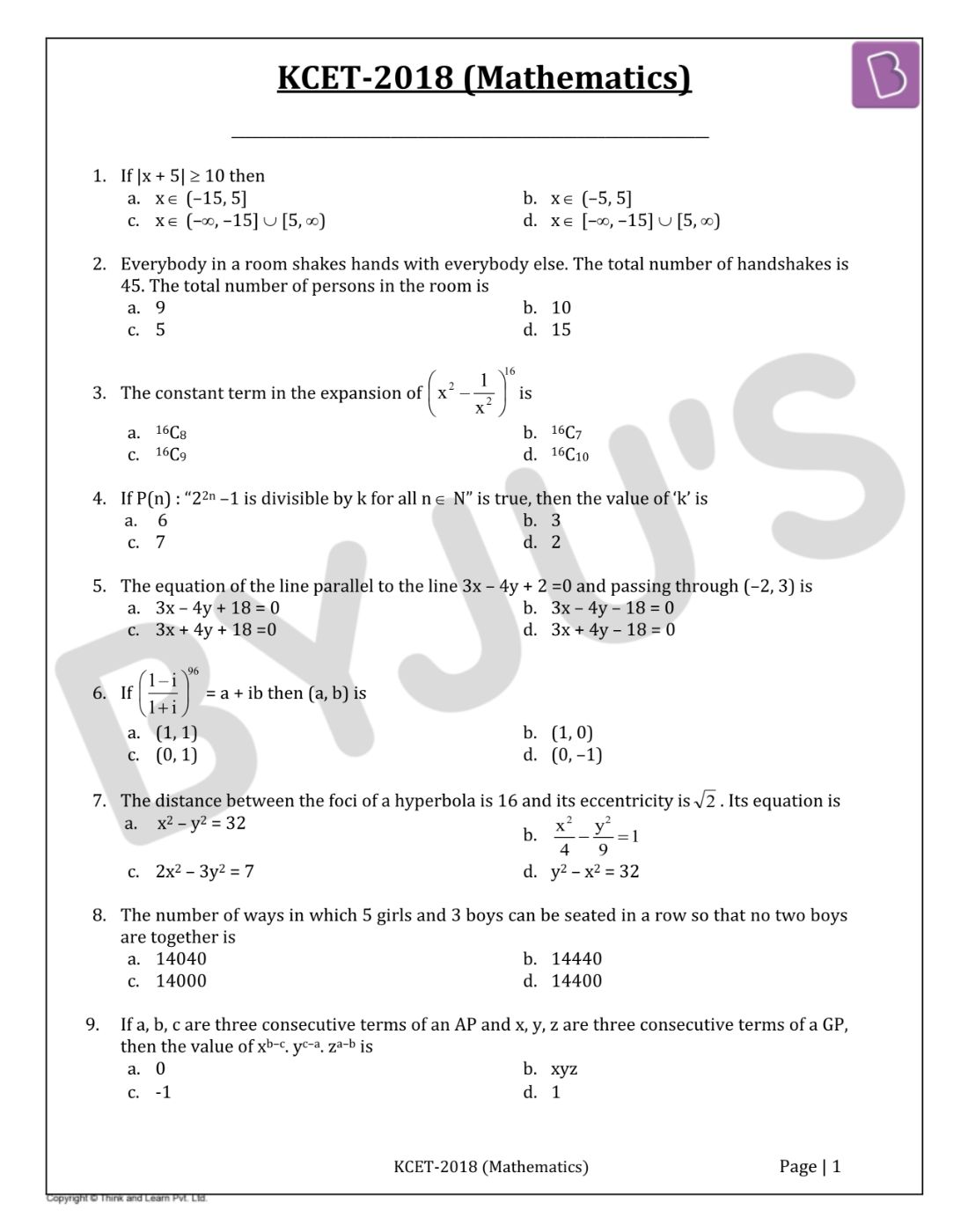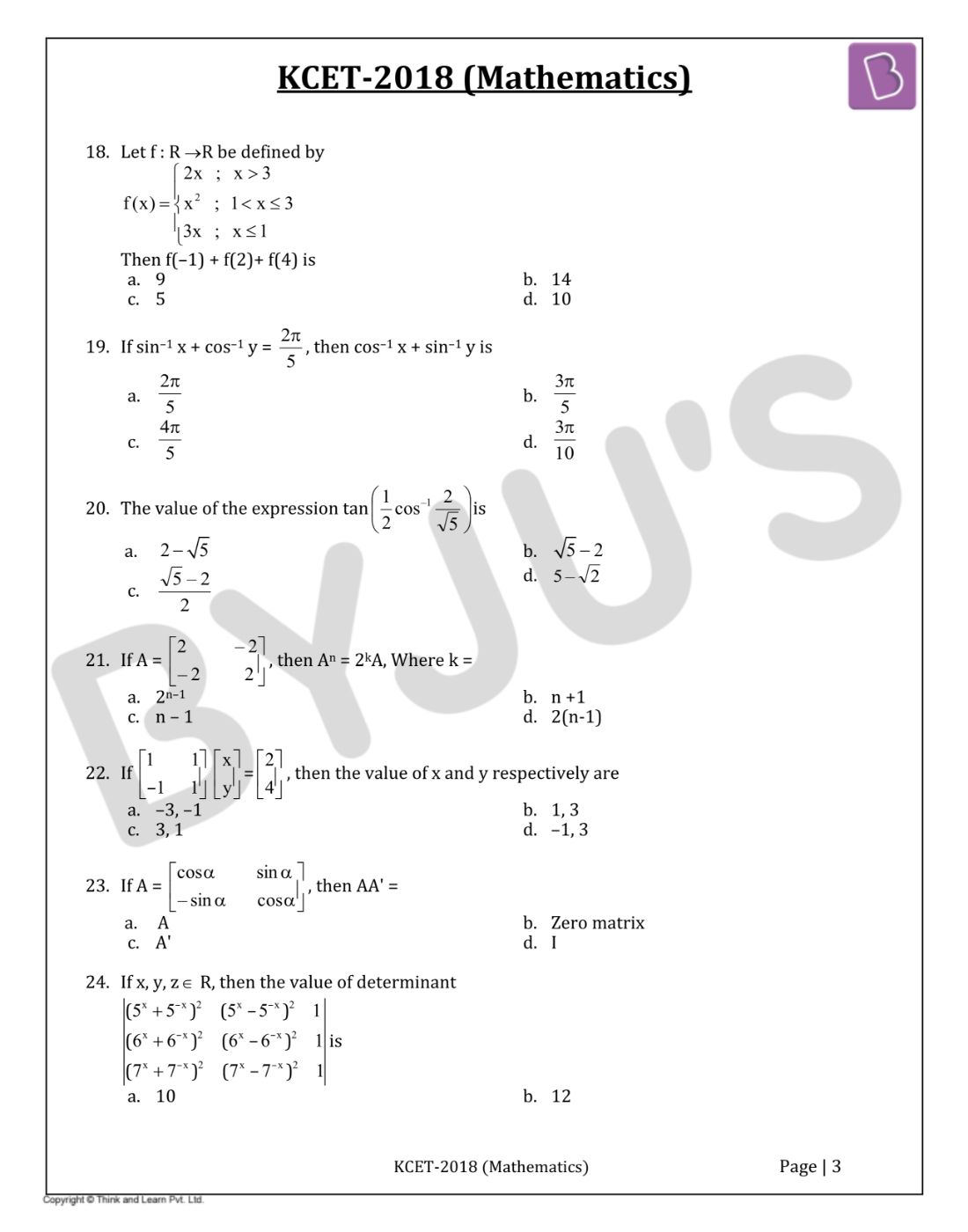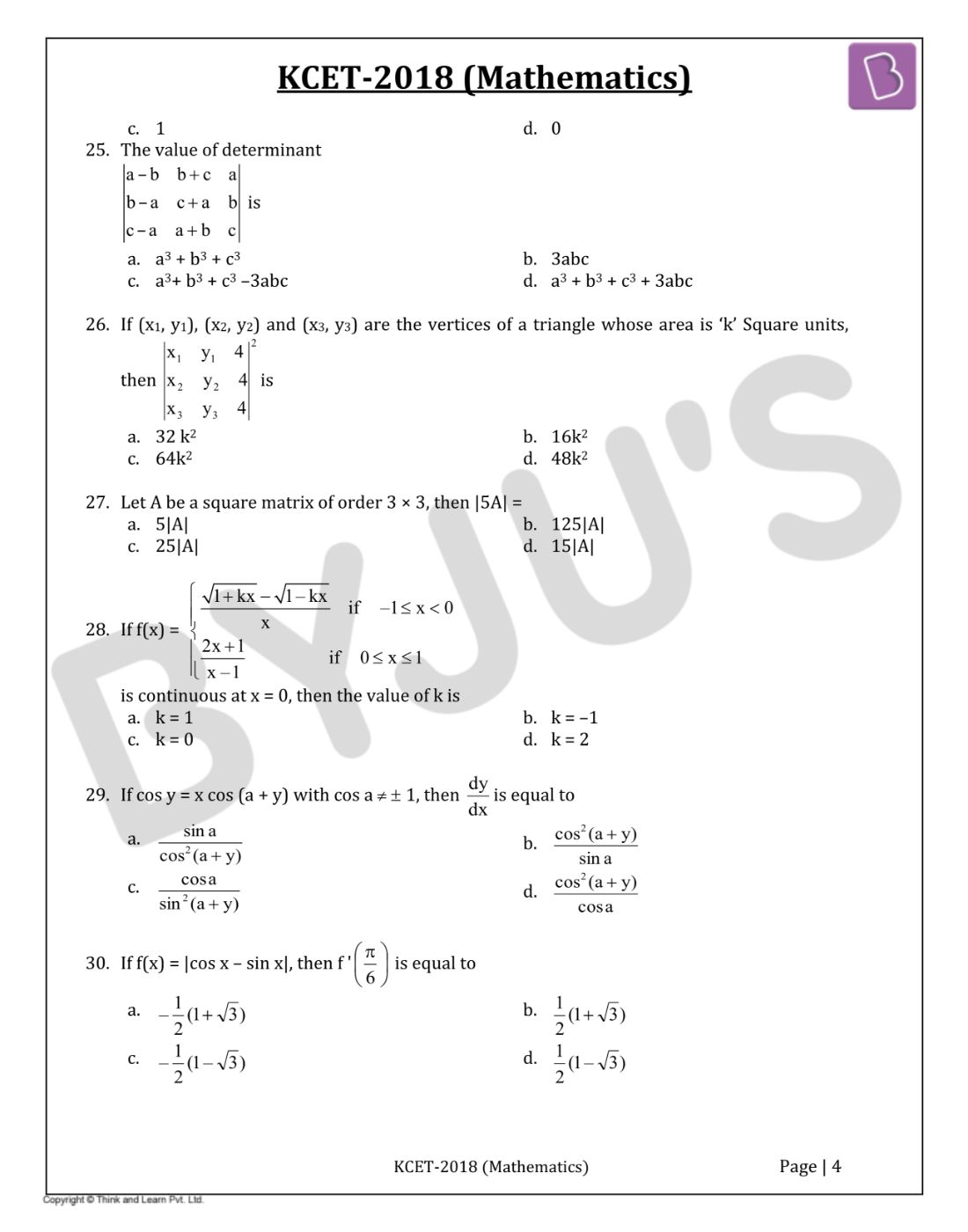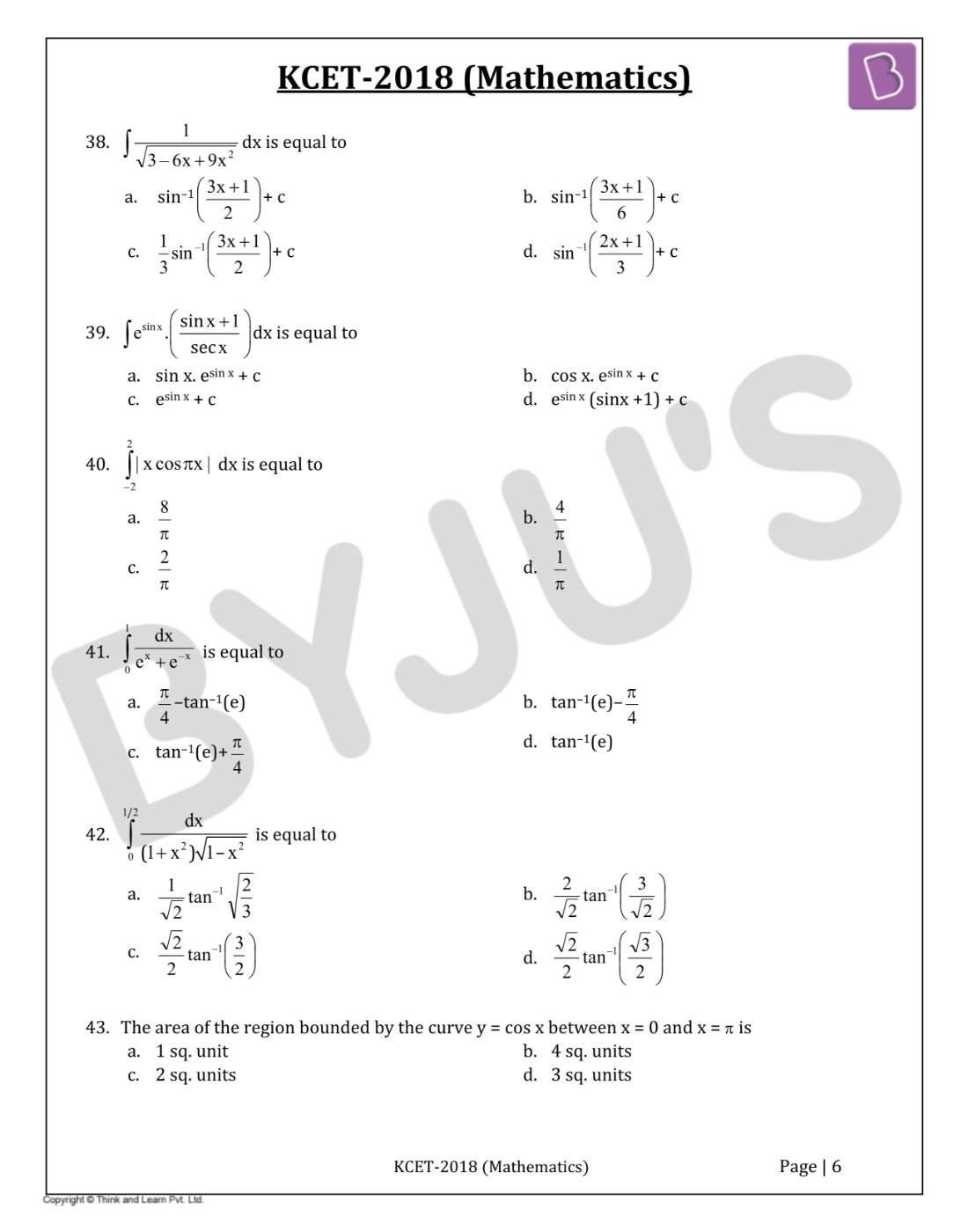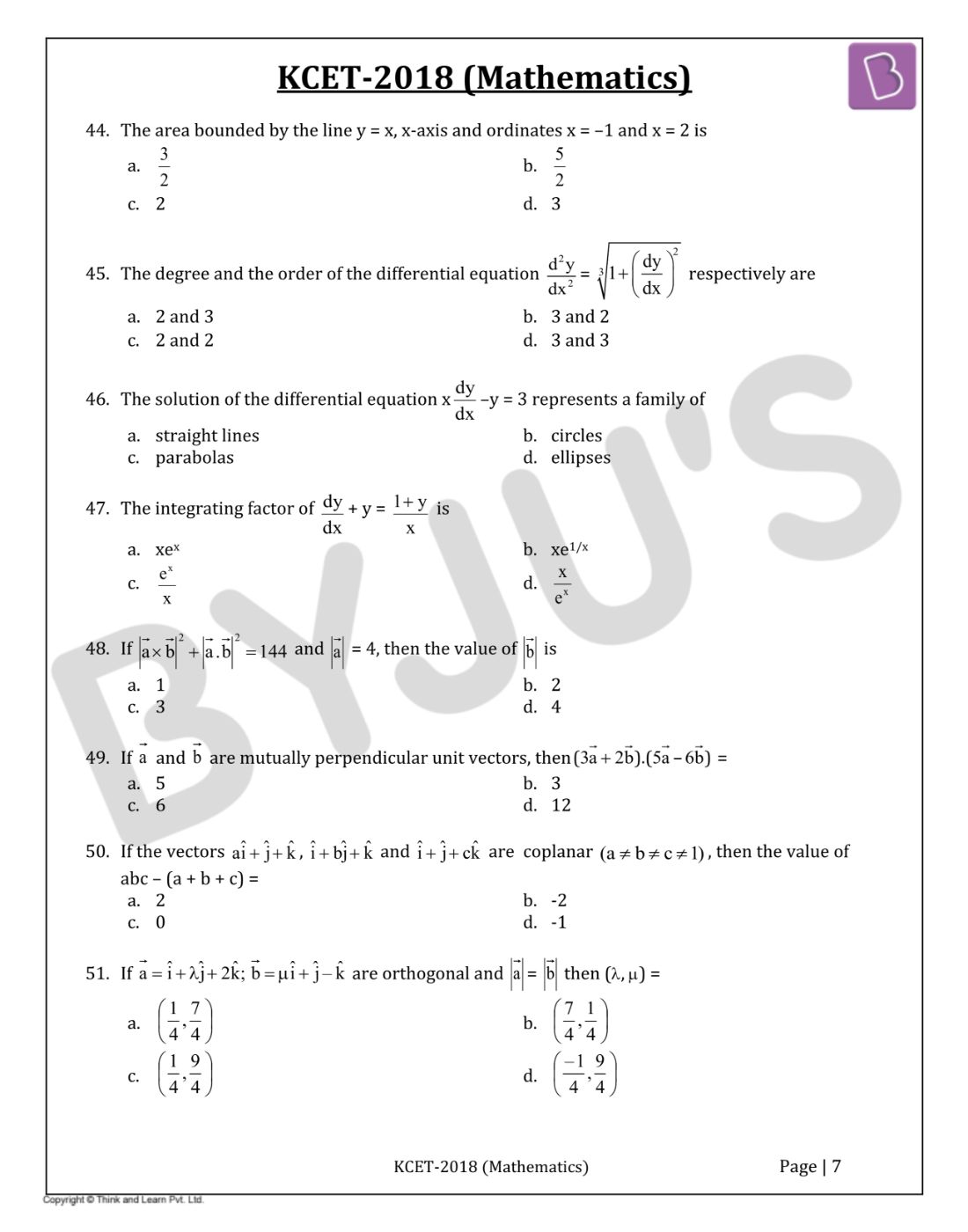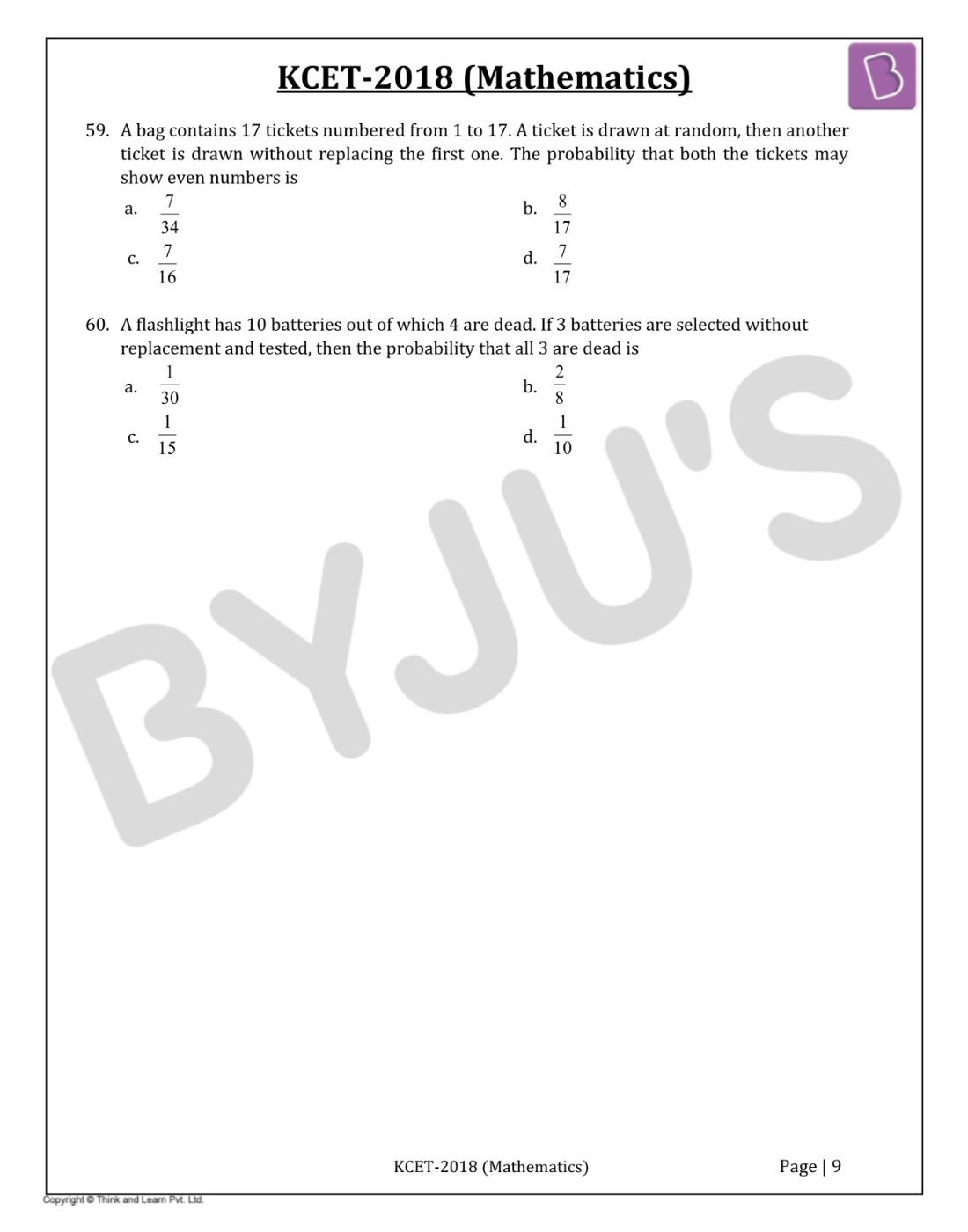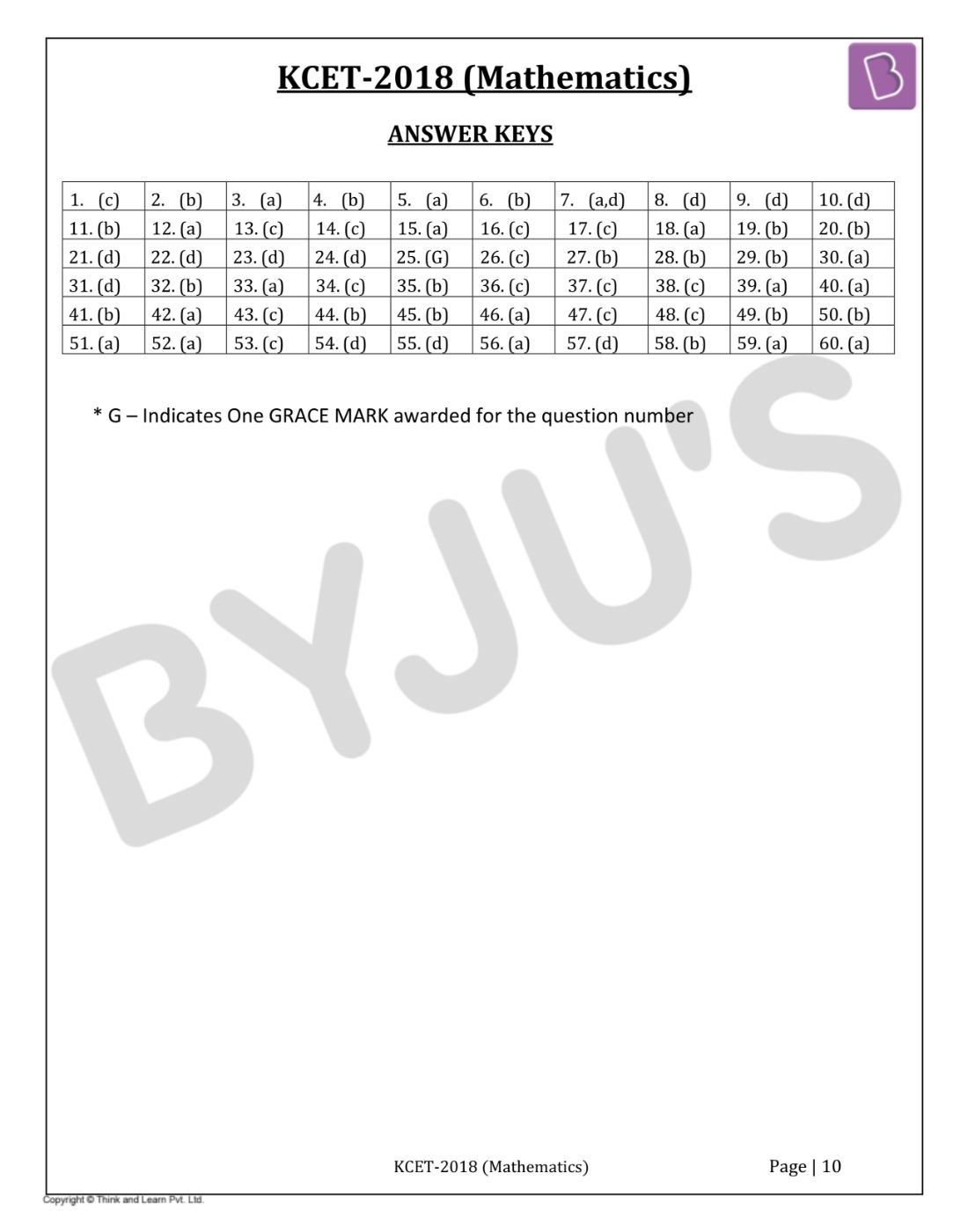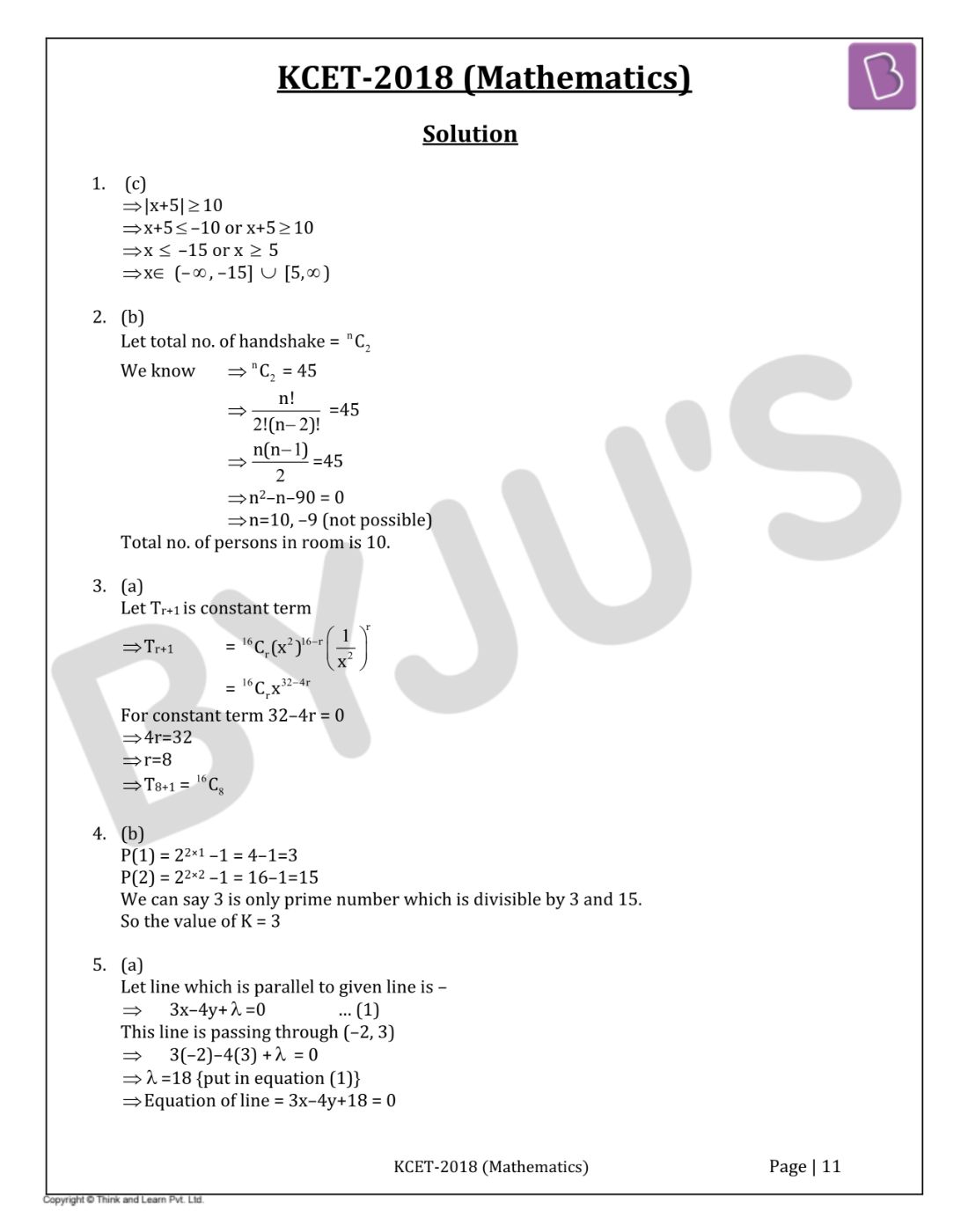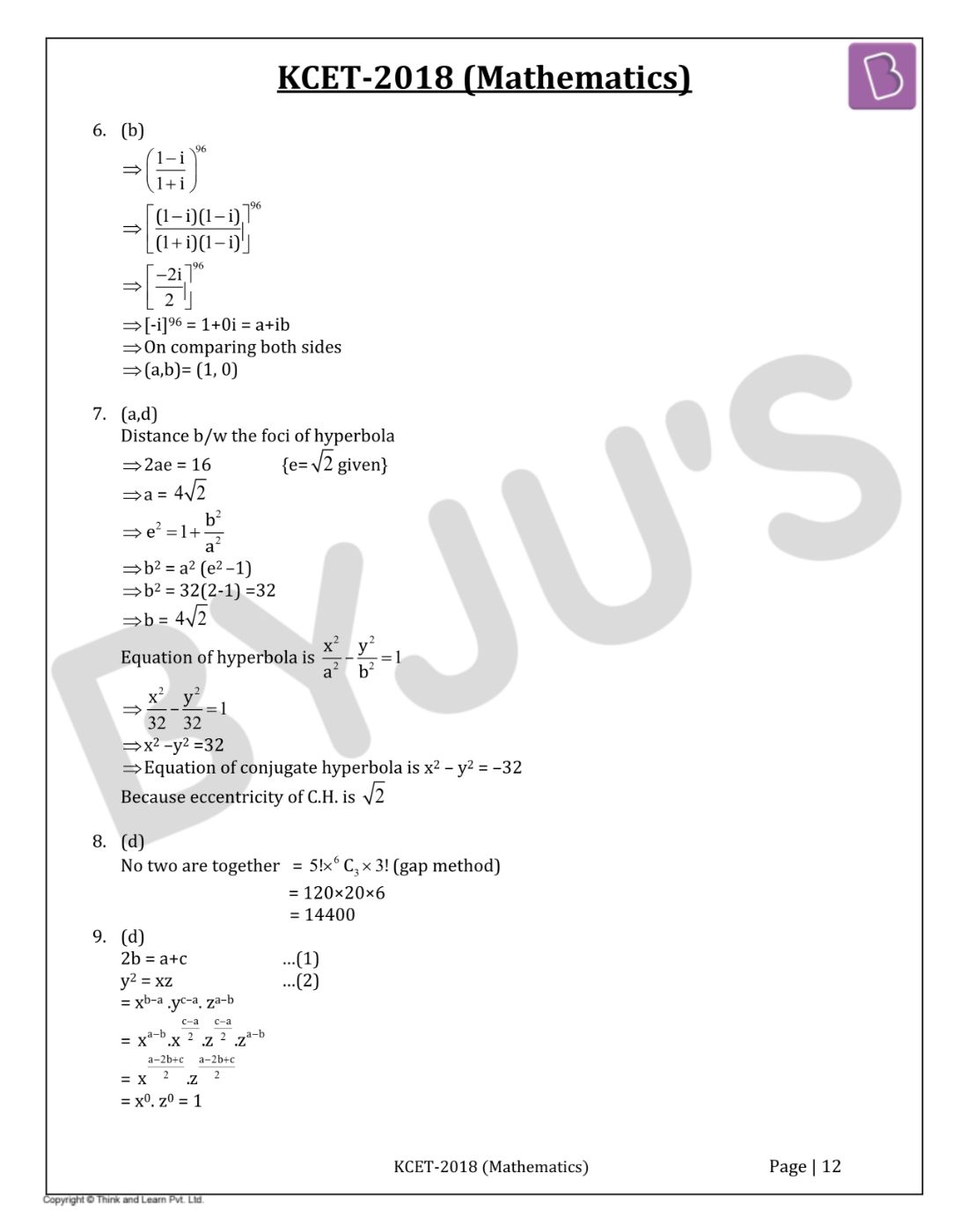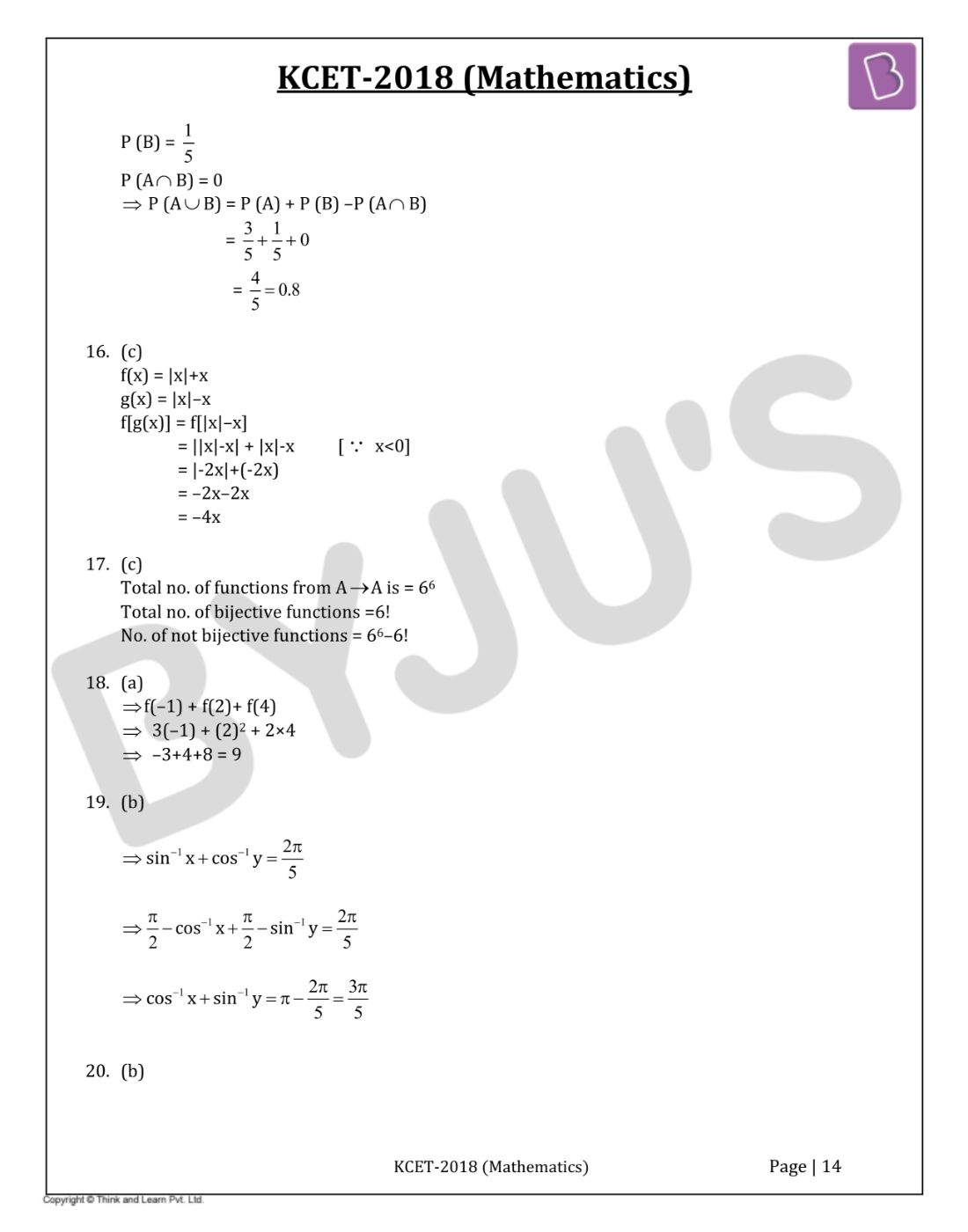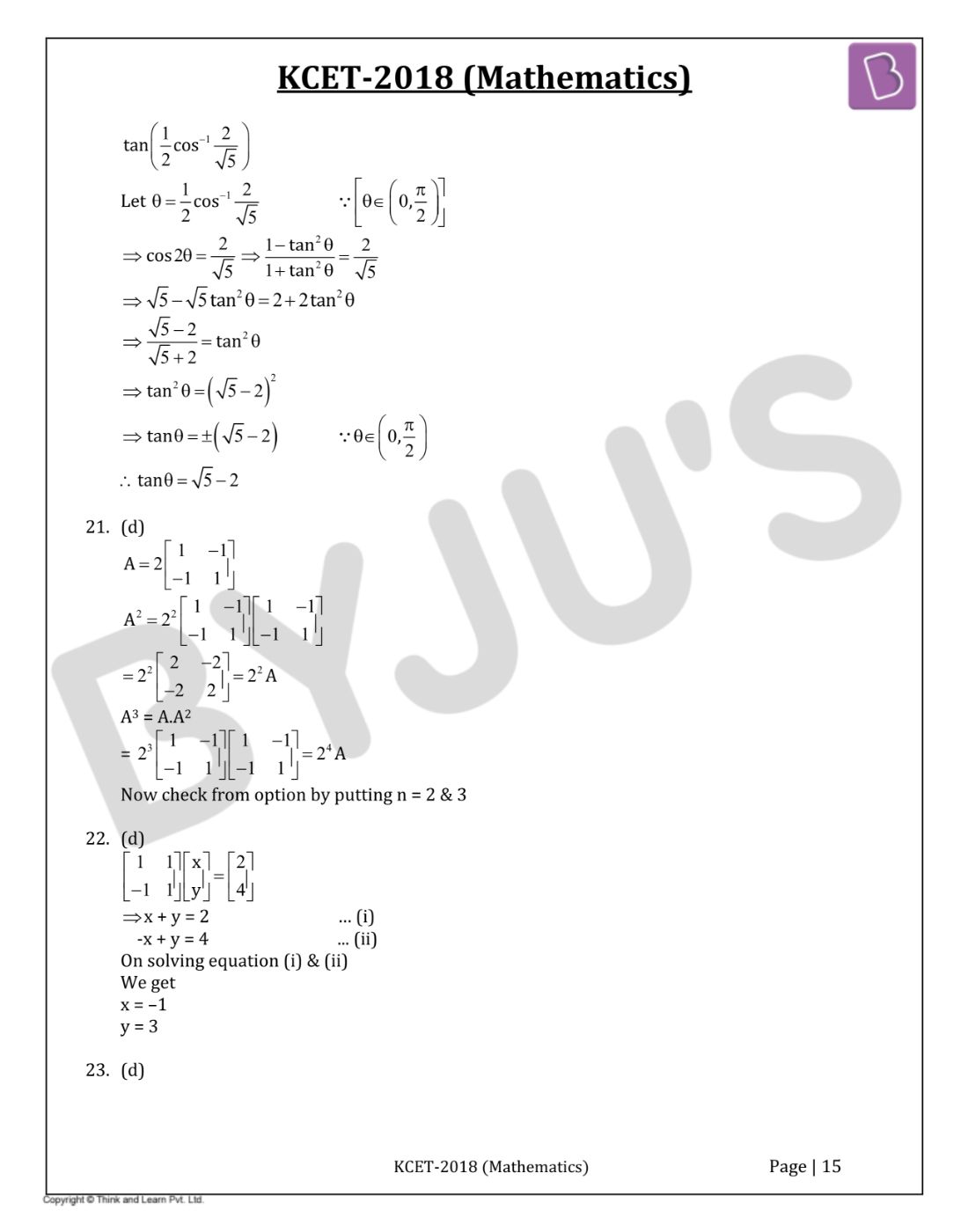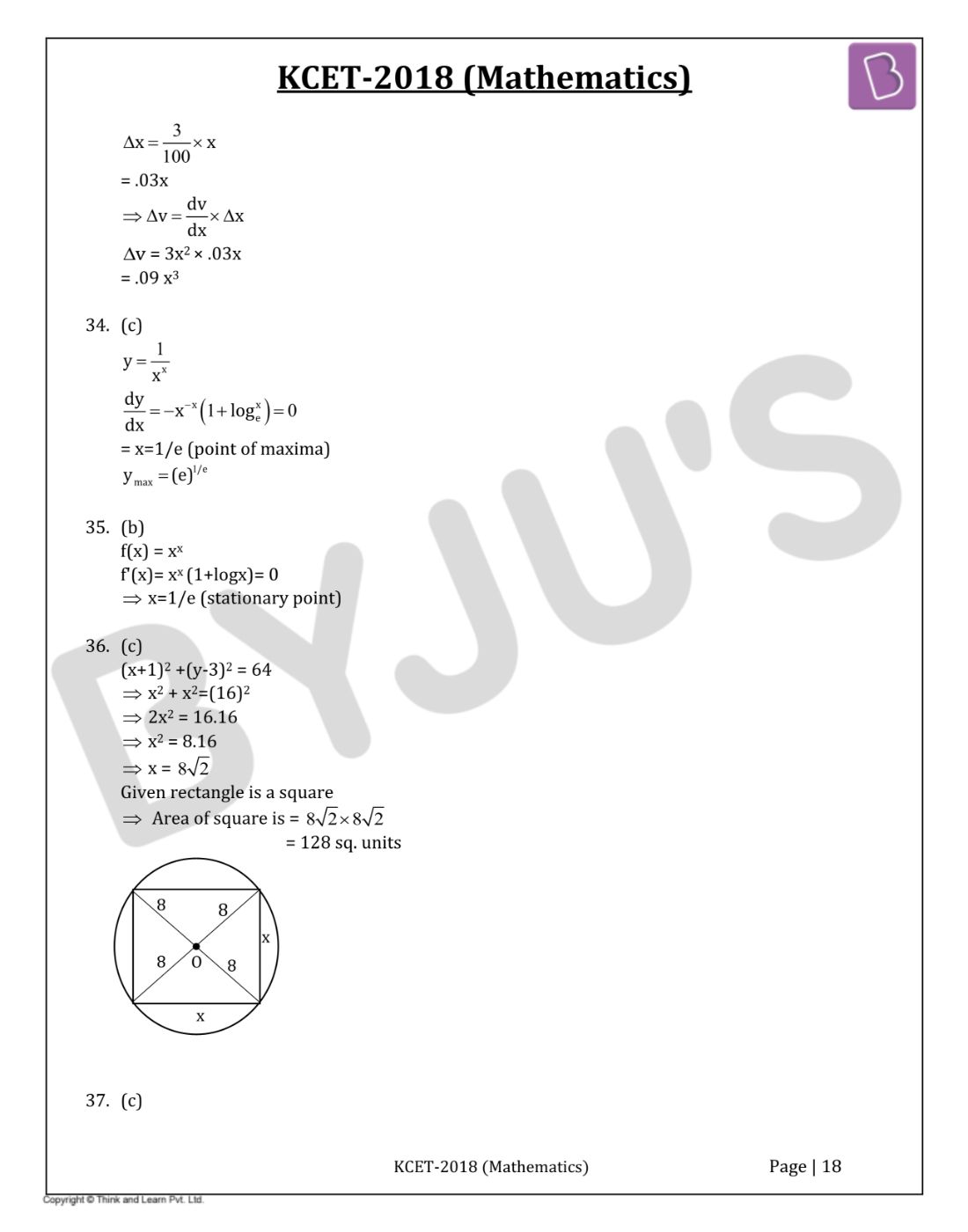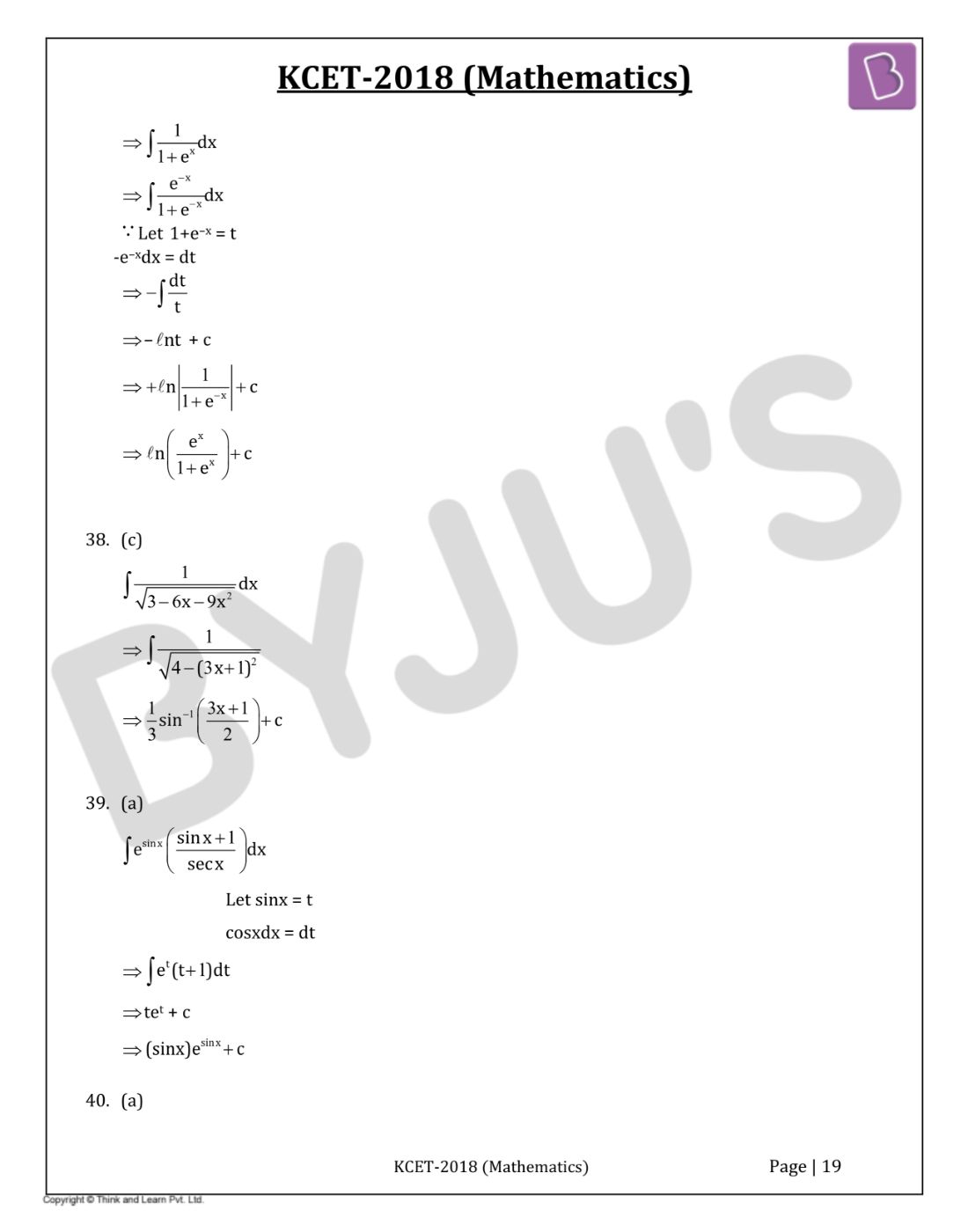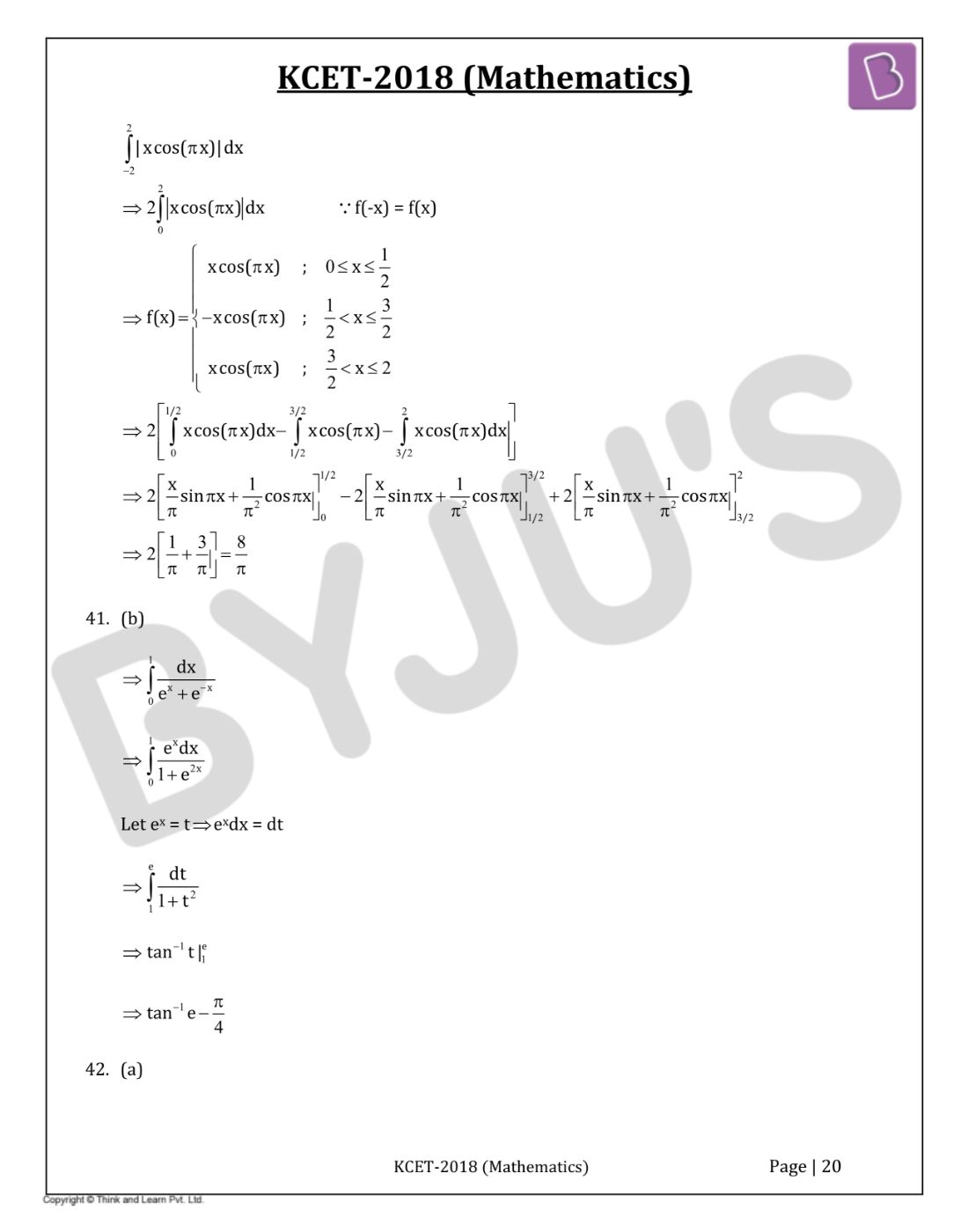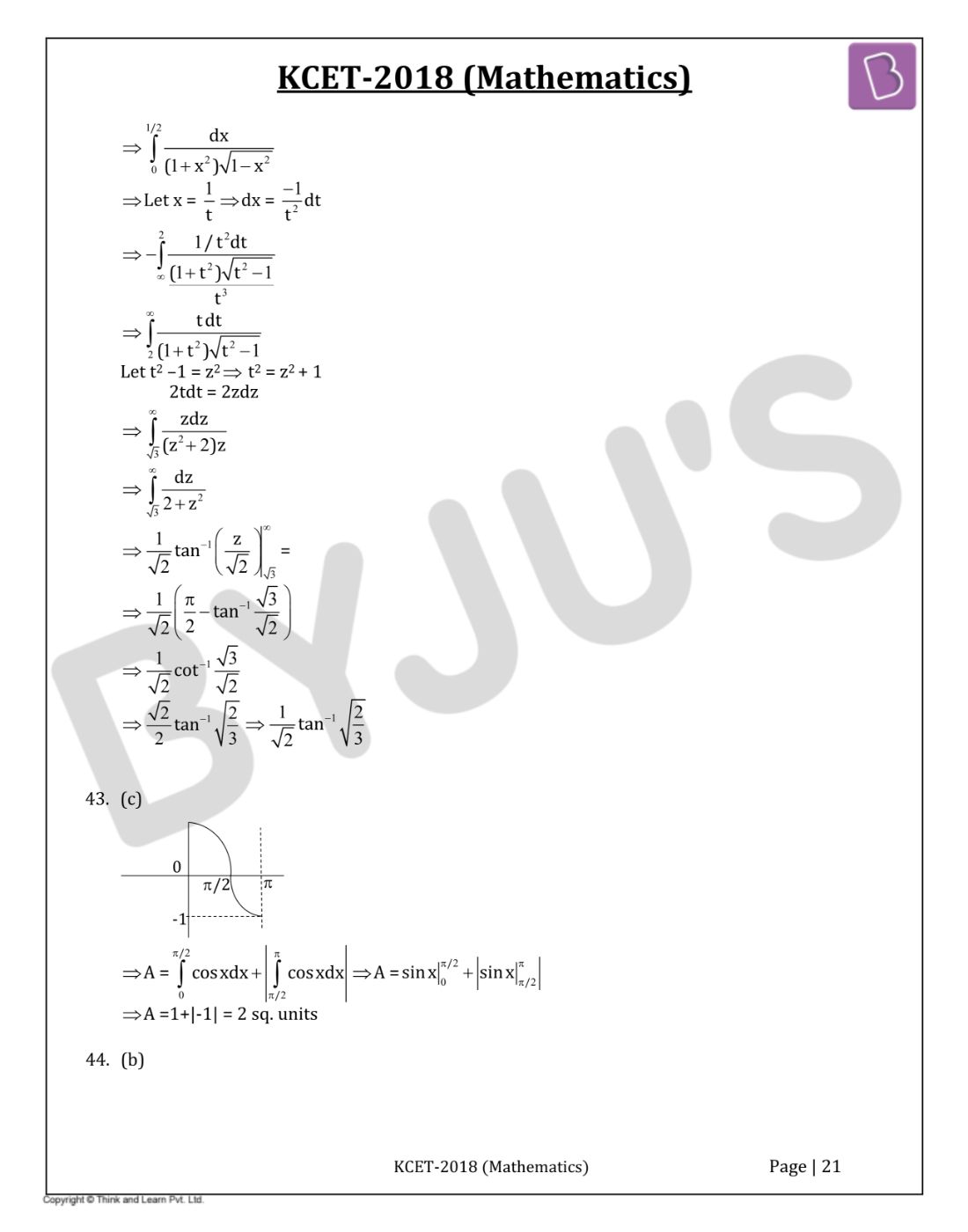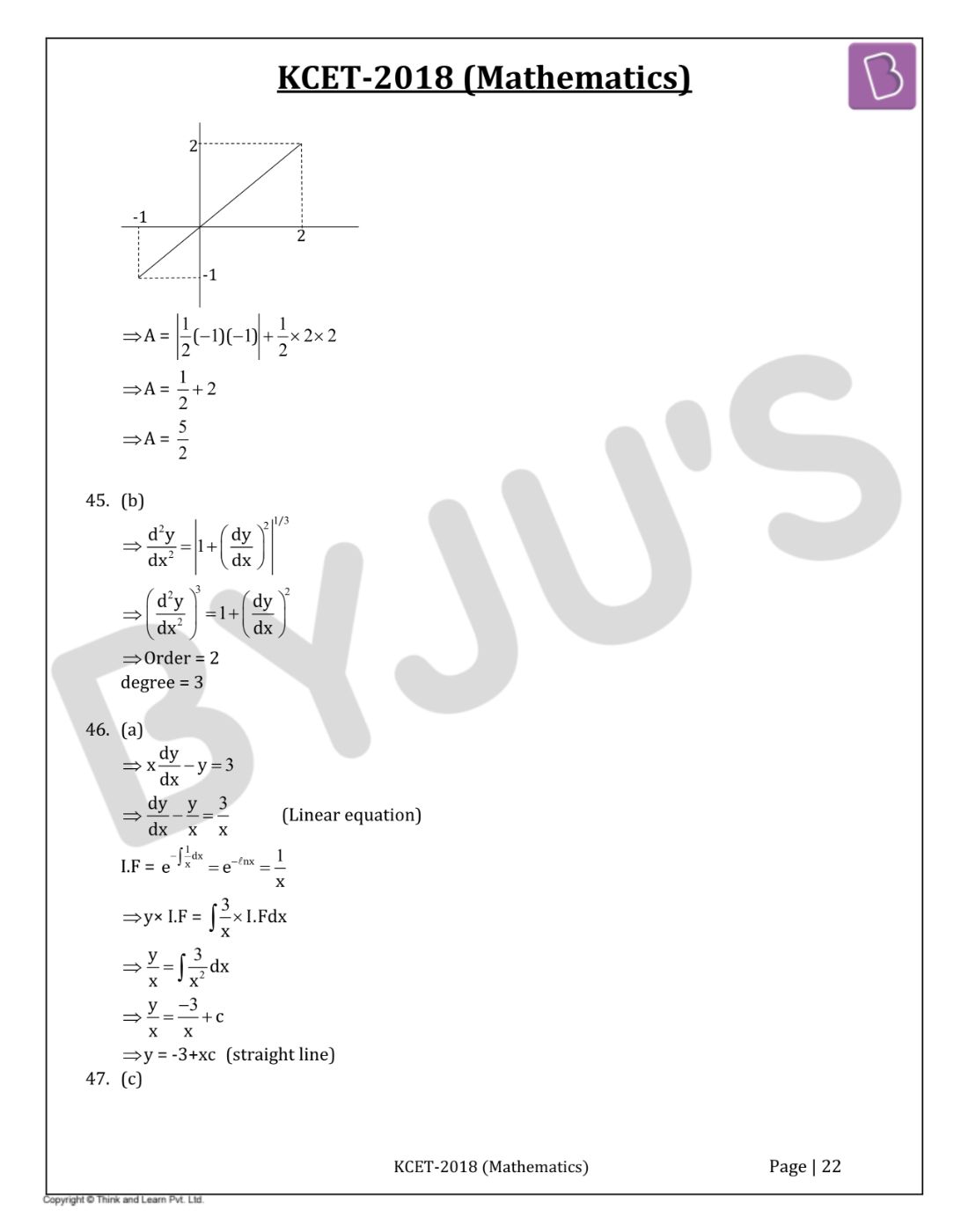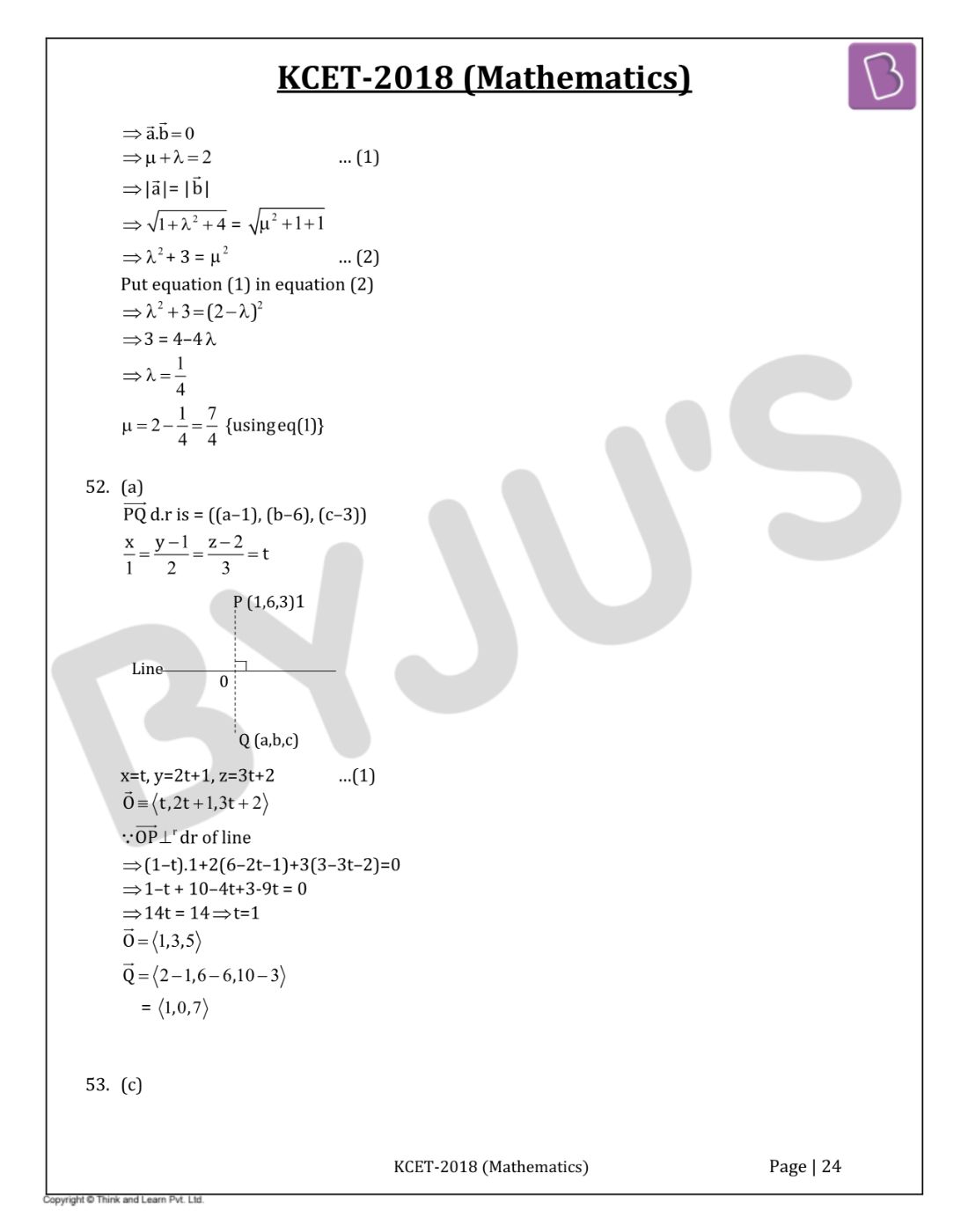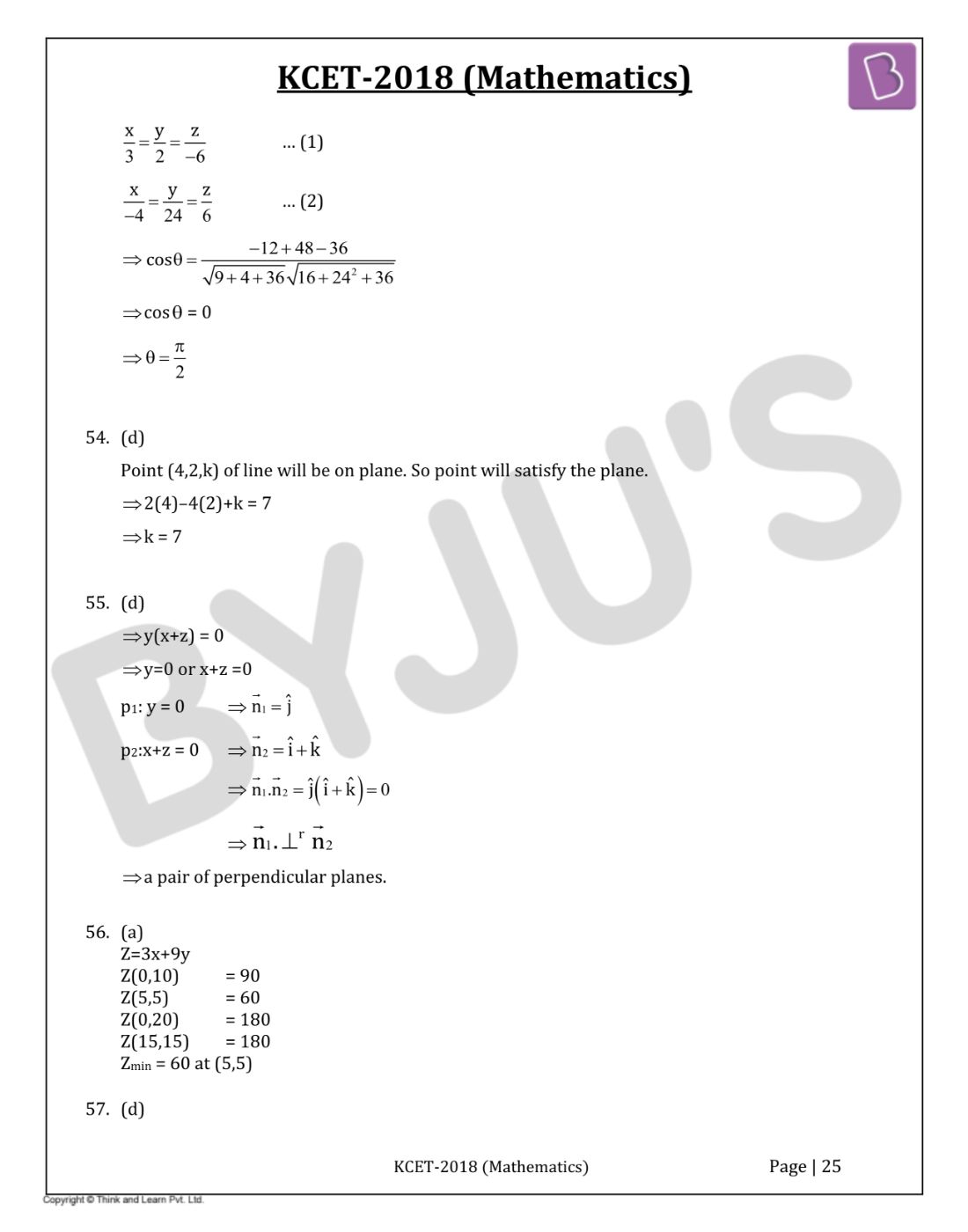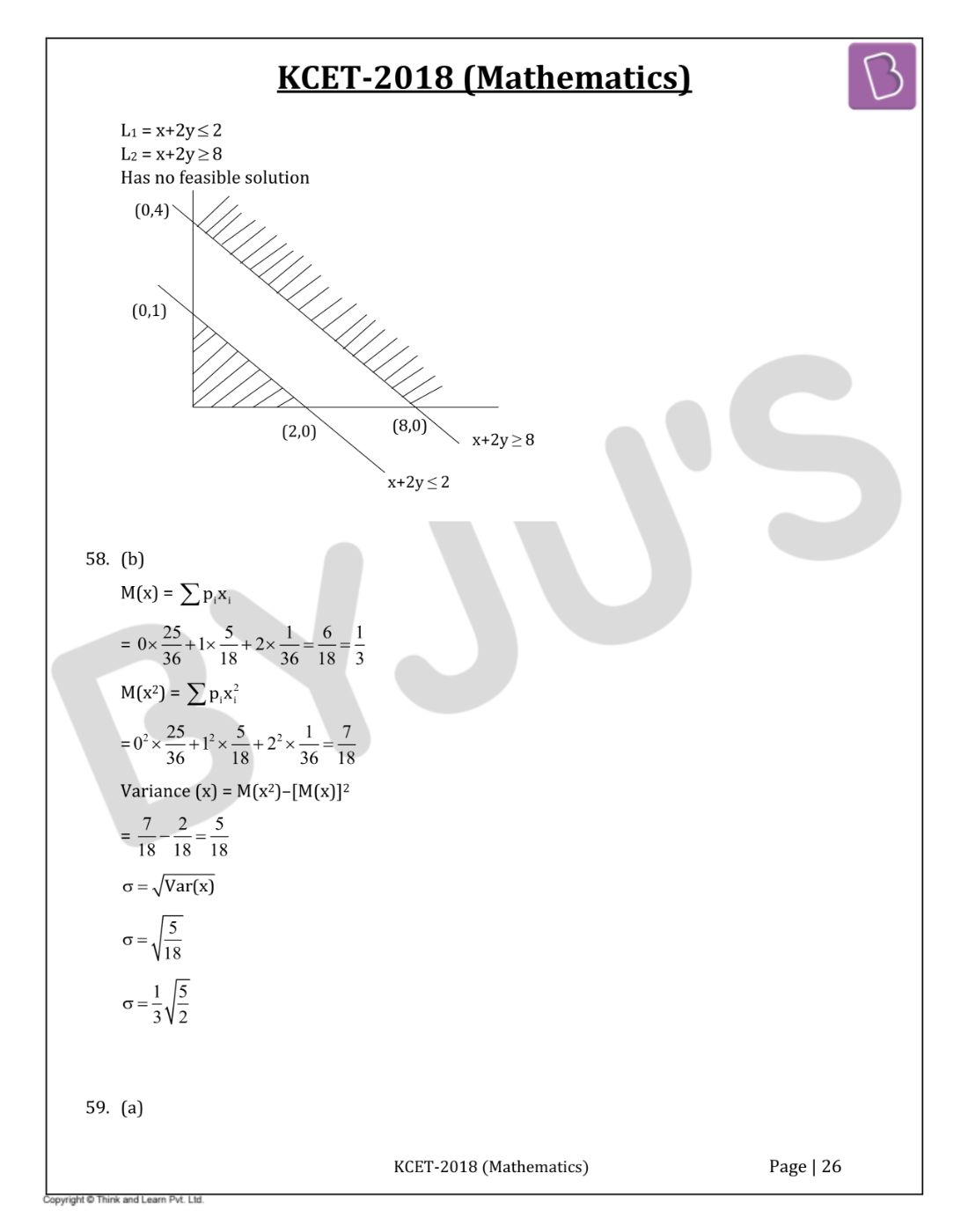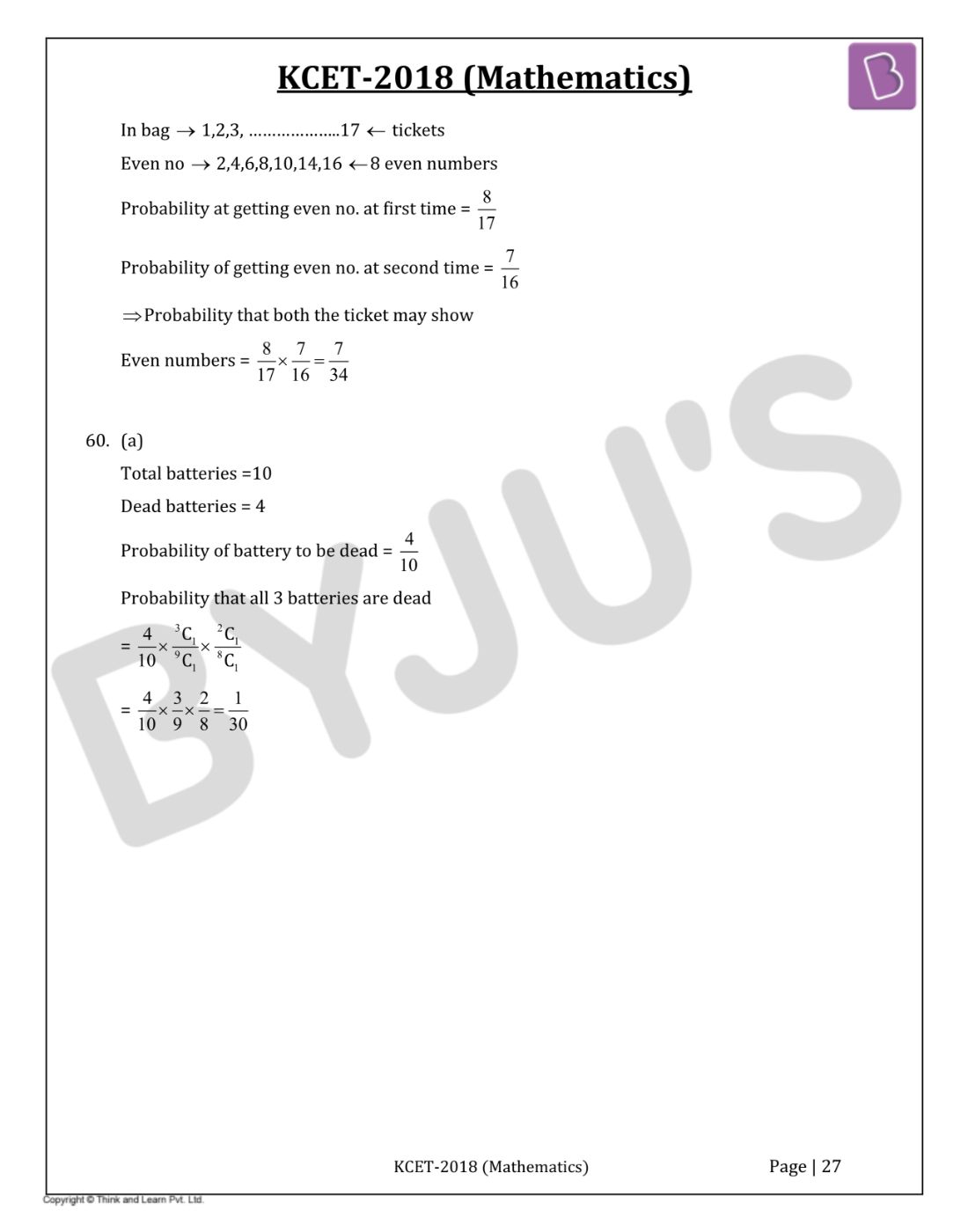KCET 2018 paper with solutions Maths is a perfect resource for those who are preparing for KCET examination. The first step towards the KCET Exam Preparation is to solve KCET Previous Year Question Papers. Along with the question paper, the answer key of KCET 2018 has also been provided here. Solving KCET previous year papers will give you an idea about the nature and pattern of questions asked in the exam. It will help the students to get a clear idea about the amount of preparation required to face the exam.
KCET 2018 - Maths
Question 1: If |x + 5| ≥ 10 then
- a. x ∈ (–15, 5]
- b. x ∈ (–5, 5]
- c. x ∈ (–∞, –15] ∪ [5, ∞)
- d. x ∈ [–∞, –15] ∪ [5, ∞)
Solution:
Answer: (c)
⇒ |x + 5| ≥ 10
⇒ x + 5 ≤ –10 or x + 5 ≥ 10
⇒ x ≤ –15 or x ≥ 5
⇒ x ∈ (–∞, –15] ∪ [5, ∞)
Question 2: Everybody in a room shakes hands with everybody else. The total number of handshakes is 45. The total number of persons in the room is
- a. 9
- b. 10
- c. 5
- d. 15
Solution:
Answer: (b)
Let the total number of handshake = nC2
We know ⇒ nC2 = 45
⇒ n! / 2! !(n - 2)! = 45
⇒ n (n - 1) / 2 = 45
⇒ n2 – n – 90 = 0
⇒ n = 10, –9 (not possible)
Total no. of persons in the room is 10.
Question 3: The constant term in the expansion of (x2 - [1 / x2])16 is
- a. 16C8
- b. 16C7
- c. 16C9
- d. 16C10
Solution:
Answer: (a)
Let Tr+1 be the constant term.
⇒ Tr+1 = 16Cr (x2)16-r (1 / x2)r
= 16Cr x32 - 4r
For constant term 32 – 4r = 0
⇒ 4r = 32
⇒ r = 8
⇒ T8+1 = 16C8
Question 4: If P (n): “22n –1 is divisible by k for all n ∈ N” is true, then the value of ‘k’ is
- a. 6
- b. 3
- c. 7
- d. 2
Solution:
Answer: (b)
P(1) = 22×1 –1 = 4 – 1 = 3
P(2) = 22×2 –1 = 16 – 1 = 15
We can say 3 is the only prime number which is divisible by 3 and 15.
So the value of K = 3
Question 5: The equation of the line parallel to the line 3x – 4y + 2 = 0 and passing through (–2, 3) is
- a. 3x – 4y + 18 = 0
- b. 3x – 4y – 18 = 0
- c. 3x + 4y + 18 = 0
- d. 3x + 4y – 18 = 0
Solution:
Answer: (a)
Let line which is parallel to given line is –
⇒ 3x – 4y + λ = 0 … (1)
This line is passing through (–2, 3)
⇒ 3 (–2) – 4 (3) + λ = 0
⇒ λ = 18 {put in equation (1)}
⇒ Equation of line = 3x – 4y + 18 = 0
Question 6: If ([1 - i] / [1 + i])96 = a + ib then (a, b) is
- a. (1, 1)
- b. (1, 0)
- c. (0, 1)
- d. (0, –1)
Solution:
Answer: (b)
⇒ ([1 - i] / [1 + i])96
\(\Rightarrow [\frac{(1-i)(1-i)}{(1+i)(1-i)}]^{96}\\ \Rightarrow [\frac{-2i}{2}]^{96}\\ \Rightarrow [-i]^{96}= 1+0i = a+ib\\\)On comparing both sides
(a, b) = (1, 0)
Question 7: The distance between the foci of a hyperbola is 16 and its eccentricity is √2. Its equation is
- a. x2 – y2 = 32
- b. [x2 / 4] - [y2 / 9] = 1
- c. 2x2 – 3y2 = 7
- d. y2 – x2 = 32
Solution:
Answer: (a, d)
Distance between the foci of the hyperbola
⇒ 2ae = 16 {e = √2 given}
⇒ a = 4√2
⇒ e2 = 1 + (b2 / a2)
⇒ b2 = a2 (e2 - 1)
⇒ b2 = 32 (2 - 1) = 32
⇒ b = 4√2
Equation of hyperbola is [x2 / a2] - [y2 / b2] = 1
⇒ [x2 / 32] - [y2 / 32] = 1
⇒ x2 - y2 = 32
⇒ Equation of conjugate hyperbola is x2 – y2 = –32
Because eccentricity of C.H. is √2.
Question 8: The number of ways in which 5 girls and 3 boys can be seated in a row so that no two boys are together is
- a. 14040
- b. 14440
- c. 14000
- d. 14400
Solution:
Answer: (d)
No two are together = 5! × 6C3 × 3! (gap method)
= 120 × 20 × 6
= 14400
Question 9: If a, b, c are three consecutive terms of an AP and x, y, z are three consecutive terms of a GP, then the value of xb–c . yc–a . za–b is
- a. 0
- b. xyz
- c. -1
- d. 1
Solution:
Answer: (d)
2b = a + c …(1)
y2 = xz …(2)
= xb–c . yc–a . za–b
= xa-b . x(c-a)/2 . z(c-a)/2 . za–b
= x(a-2b+c)/2 . z(a-2b+c)/2
= x0 . z0 = 1
Question 10: The value of limx→0 |x| / x is
- a. 1
- b. -1
- c. 0
- d. Does not exist
Solution:
Answer: (d)
LHL: limx→0- [-x / x] = -1
RHL: limx→0+ [x / x] = 1
⇒ LHL ≠ RHL
⇒ The limit does not exist.
Question 11: Let f (x) = x – (1 / x) then f’(–1) is
- a. 0
- b. 2
- c. 1
- d. -2
Solution:
Answer: (b)
f (x) = x – (1 / x)
On differentiating
f ‘ (x) = 1 + (1 / x2)
f’ (-1) = 1 + (1 / 1) = 2
Question 12: The negation of the statement “72 is divisible by 2 and 3” is
- a. 72 is not divisible by 2 or 72 is not divisible by 3
- b. 72 is divisible by 2 or 72 is divisible by 3
- c. 72 is divisible by 2 and 72 is divisible by 3
- d. 72 is not divisible by 2 and 3
Solution:
Answer: (a)
p : 72 is divisible by 2
q : 72 is divisible by 3
p: 72 is not divisible by 2
q : 72 is not divisible by 3
⇒ (p ∧ q) = p ∨ q
⇒ 72 is not divisible by 2 or 72 is not divisible by 3.
Question 13: The probability of happening of an event A is 0.5 and that of B is 0.3. If A and B are mutually exclusive events, then the probability of neither A nor B is
- a. 0.4
- b. 0.5
- c. 0.2
- d. 0.9
Solution:
Answer: (c)
P (A) = 0.5
P (B) = 0.3
P (A ∩ B) = 0
P (A ∪ B) = P (A) + P (B) – P (A ∩ B)
= 0.5 + 0.3 – 0 = 0.8
⇒ P (A ∪ B)' = 1 – P (A ∪ B)
= 1 - 0.8 = 0.2
Question 14: In a simultaneous throw of a pair of dice, the probability of getting a total of more than 7 is
- a. 7 / 12
- b. 5 / 36
- c. 5 / 12
- d. 7 / 36
Solution:
Answer: (c)
No. of ways of getting total more than 7 = {(6, 6), (6, 5), (5, 6), (6, 4), (4, 6), (6, 3), (3, 6), (6, 2), (2, 6), (5, 5), (5, 4), (4, 5), (5, 3), (3, 5), (4, 4)}= 15
Probability of getting total more than 7 is = 15 / 36 = 5 / 12
Question 15: If A and B are mutually exclusive events given that P (A) = 3 / 5, P (B) = 1 / 5, then P (A or B) is
- a. 0.8
- b. 0.6
- c. 0.4
- d. 0.2
Solution:
Answer: (a)
P (A) = 3 / 5
P (B) = 1 / 5
P (A ∩ B) = 0
P (A ∪ B) = P (A) + P (B) – P (A ∩ B)
= (3 / 5) + (1 / 5) + 0
= 4 / 5 = 0.8
Question 16: Let f, g : R → R be two functions define as f (x) = |x| + x and g (x) = |x| – x ∀ x ∈ R. Then (fog) (x) for x < 0 is
- a. 0
- b. 4x
- c. -4x
- d. 2x
Solution:
Answer: (c)
f (x) = |x| + x
g (x) = |x| – x
f [g (x)] = f [|x| – x]
= ||x| - x| + |x| - x [x < 0]
= |-2x| + (-2x)
= –2x –2x
= –4x
Question 17: A is a set having 6 distinct elements. The number of distinct functions from A to A which are not bijections is
- a. 6! – 6
- b. 66 – 6
- c. 66 – 6!
- d. 6!
Solution:
Answer: (c)
Total no. of functions from A → A is = 66
Total no. of bijective functions = 6!
No. of not bijective functions = 66 – 6!
Question 18: Let f : R → R be defined by
Then f (–1) + f (2) + f (4) is
- a. 9
- b. 14
- c. 5
- d. 10
Solution:
Answer: (a)
⇒ f (–1) + f (2)+ f (4)
⇒ 3 (–1) + (2)2 + 2 × 4
⇒ –3 + 4 + 8 = 9
Question 19: If sin-1 x + cos-1 y = 2π / 5, then cos-1 x + sin-1 y is
- a. 2π / 5
- b. 3π / 5
- c. 4π / 5
- d. 3π / 10
Solution:
Answer: (b)
⇒ sin-1 x + cos-1 y = 2π / 5
⇒ (π / 2) - cos-1 x + (π / 2) - sin-1 y = 2π / 5
⇒ cos-1 x + sin-1 y = π - (2π / 5) = 3π / 5
Question 20: The value of the expression tan [(1 / 2) cos-1 (2 / √5)] is
- a. 2 − √5
- b. √5 − 2
- c. [√5 − 2] / 2
- d. 5 – √2
Solution:
Answer: (b)
tan [(1 / 2) cos-1 (2 / √5)]
Let θ = (1 / 2) cos-1 (2 / √5) ∵ [θ ∈ (0, [π / 2])]
⇒ cos 2θ = 2 / √5 ⇒ (1 - tan2 θ) / (1 + tan2 θ) = 2 / √5
⇒ √5 - √5 tan2 θ = 2 + 2 tan2 θ
⇒ [√5 - 2] / [√5 + 2] = tan2 θ
⇒ tan2 θ = (√5 - 2)2
⇒ tan θ = ∓ (√5 - 2) ∵ [θ ∈ (0, [π / 2])]
tan θ = √5 - 2
Question 21: If , then An = 2kA, Where k =
, then An = 2kA, Where k =
- a. 2n–1
- b. n +1
- c. n – 1
- d. 2 (n - 1)
Solution:
Answer: (d)

Now check from option by putting n = 2 & 3
Question 22: If then the value of x and y respectively are
then the value of x and y respectively are
- a. –3, –1
- b. 1, 3
- c. 3, 1
- d. –1, 3
Solution:
Answer: (d)

x + y = 2 … (i)
-x + y = 4 ... (ii)
On solving equation (i) & (ii)
We get
x = –1
y = 3
Question 23: If then AA’ =
then AA’ =
- a. A
- b. Zero matrix
- c. A'
- d. I
Solution:
Answer: (d)
\(\\AA'=\begin{bmatrix} cos \alpha &sin \alpha \\ -sin \alpha& cos \alpha \end{bmatrix}\begin{bmatrix} cos \alpha &-sin \alpha \\ sin \alpha& cos \alpha \end{bmatrix}\\ =\begin{bmatrix} 1 &0 \\ 0&1 \end{bmatrix} =I\)
Question 24: If x, y, z ∈ R, then the value of the determinant  is
is
- a. 10
- b. 12
- c. 1
- d. 0
Solution:
Answer: (d)

Question 25: The value of the determinant is
is
- a. a3 + b3 + c3
- b. 3abc
- c. a3 + b3 + c3 –3abc
- d. a3 + b3 + c3 + 3abc
Solution:
Answer: Bonus
Question 26: If (x1, y1), (x2, y2) and (x3, y3) are the vertices of a triangle whose area is ‘k’ square units, then  is
is
- a. 32 k2
- b. 16 k2
- c. 64 k2
- d. 48 k2
Solution:
Answer: (c)

Question 27: Let A be a square matrix of order 3 × 3, then |5A| =
- a. 5|A|
- b. 125|A|
- c. 25|A|
- d. 15|A|
Solution:
Answer: (b)
|5A| = 53 |A| = 125 |A|
Question 28: If f (x) =

is continuous at x = 0, then the value of k is
- a. k = 1
- b. k = –1
- c. k = 0
- d. k = 2
Solution:
Answer: (b)

L.H.L = R.H.L
k = –1
Question 29: If cos y = x cos (a + y) with cos a ≠ ± 1, then dy / dx is equal to
- a. sin a / cos2 (a + y)
- b. cos2 (a + y) / sin a
- c. cos a / sin2 (a + y)
- d. cos2 (a + y) / cos a
Solution:
Answer: (b)
cosy = x cos (a + y)
⇒ x = [cos y] / [cos (a + y)]
⇒ 1 = {[– cos (a + y) sin y + cos y sin (a + y)] (dy / dx)} / {cos2 (a + y)}
⇒ dy / dx = [cos2 (a + y)] / sin a
Question 30: If f (x) = |cos x - sin x|, then f ‘(π / 6) is equal to
- a. (-1 / 2) (1 + √3)
- b. (1 / 2) (1 + √3)
- c. (-1 / 2) (1 - √3)
- d. (1 / 2) (1 - √3)
Solution:
Answer: (a)
f (x) = | cosx – sinx |
At x = π / 6,
f (x) = cosx – sinx
f’(x) = – sinx – cosx
f ‘ (π / 6) = (-1 / 2) - (√3 / 2) = (-1 / 2) (1 + √3)
Question 31: If y =
- a. 1 / [y2 - 1]
- b. 1 / [2y + 1]
- c. 2y / [y2 - 1]
- d. 1 / [2y – 1]
Solution:
Answer: (d)
y = √x + y
y2 - y - x = 0
2y (dy / dx) - (dy / dx) - 1 = 0
dy / dx = 1 / (2y - 1)
Question 32: If f (x) =  is continuous at x = 1, then the value of k is
is continuous at x = 1, then the value of k is
- a. e
- b. 1
- c. -1
- d. 0
Solution:
Answer: (b)
limx→1 [loge x / (x - 1)] [0 / 0]
Using L-Hospital Rule
limx→1 (1 / x) / 1 = 1
LHL = RHL = f (1)
1 = k
Question 33: Approximate change in volume V of a cube of side x metres caused by increasing the size by 3% is
- a. 0.09 x3 m3
- b. 0.03 x3 m3
- c. 0.06 x3 m3
- d. 0.04 x3 m3
Solution:
Answer: (a)
Δx = (3 / 100) × x = 0.03 x
Δv = (dv / dx) × Δx
Δv = 3x2 . 0.03x
= 0.09 x3
Question 34: The maximum value of (1 / x)x is
- a. e
- b. ee
- c. e1/e
- d. [1 / e]1/e
Solution:
Answer: (c)
y = 1 / xx
dy / dx = -x-x (1 + loge x) = 0
= x = 1 / e (point of maxima)
ymax = (e)1/e
Question 35: f (x) = xx has stationary point at
- a. x = e
- b. x = 1 / e
- c. x = 1
- d. x = √e
Solution:
Answer: (b)
f (x) = xx
f ‘ (x) = xx (1 + logx) = 0
x = 1 / e (stationary point)
Question 36: The maximum area of a rectangle inscribed in the circle (x + 1)2 + (y – 3)2 = 64 is
- a. 64 sq. units
- b. 72 sq. units
- c. 128 sq. units
- d. 8 sq. units
Solution:
Answer: (c)

(x + 1)2 + (y - 3)2 = 64
x2 + x2 = (16)2
2x2 = 16 . 16
x2 = 8.16
x = 8√2
Given rectangle is a square
Area of square is = 8 √2 * 8 √2
= 128 sq. units
Question 37: ∫(1 / [1 + ex]) dx is equal to
- a. loge [(ex + 1) / ex] + c
- b. loge [(ex - 1) / ex] + c
- c. loge [(ex) / (ex + 1)] + c
- d. loge [(ex) / (ex - 1)] + c
Solution:
Answer: (c)
⇒ ∫(1 / [1 + ex]) dx
⇒ ∫(e-x / [1 + e-x]) dx
Let 1 + e–x = t
-e-x dx = dt
⇒ -∫dt / t
⇒ - lnt + c
⇒ ln |(1 / [1 + e-x])| + c
⇒ ln (ex / [1 + ex]) + c
Question 38: ∫1 / (√3 - 6x + 9x2) dx is equal to
- a. sin-1 ([3x + 1] / 2) + c
- b. sin-1 ([3x + 1] / 6) + c
- c. (1 / 3) sin-1 ([3x + 1] / 2) + c
- d. sin-1 ([2x + 1] / 3) + c
Solution:
Answer: (c)
∫1 / (√3 - 6x + 9x2) dx
= ∫1 / (√4 - (3x + 1)2
= (1 / 3) sin-1 ([3x + 1] / 2) + c
Question 39: ∫esinx * ([sinx + 1] / secx) dx is equal to
- a. sin x. esin x + c
- b. cos x. esin x + c
- c. esin x + c
- d. esin x (sinx +1) + c
Solution:
Answer: (a)
∫esinx * ([sinx + 1] / secx) dx
Let sinx = t
cosxdx = dt
= ∫et (t + 1) dt
= tet + c
sin x. esin x + c
Question 40: ∫-22 | x cos πx| dx is equal to
- a. 8 / π
- b. 4 / π
- c. 2 / π
- d. 1 / π
Solution:
Answer: (a)

Question 41: ∫01 dx / (ex + e-x) is equal to
- a. (π / 4) - tan-1 e
- b. tan-1 e - (π / 4)
- c. tan-1 e + (π / 4)
- d. tan-1 e
Solution:
Answer: (b)
∫01 dx / (ex + e-x)
= ∫01 ex dx / [1 + e2x]
Let ex = t
ex dx = dt
= ∫1e dt / (1 + t2 )
= tan-1 (t)1e
= tan-1 e - (π / 4)
Question 42: ∫01/2 dx / [(1 + x2) √1 - x2] is equal to
- a. (1 / √2) tan-1 (√(2 / 3))
- b. (2 / √2) tan-1 (3 / √2)
- c. (√2 / 2) tan-1 (3 / 2)
- d. (√2 / 2) tan-1 (√3 / 2)
Solution:
Answer: (a)

Question 43: The area of the region bounded by the curve y = cos x between x = 0 and x = π is
- a. 1 sq. unit
- b. 4 sq. units
- c. 2 sq. units
- d. 3 sq. units
Solution:
Answer: (c)

A = ∫0π/2 cosx dx + |∫π/2π cos xdx|
A = sinx|0π/2 + |sinx|π/2π
A = 1 + |-1|
= 2 sq. units
Question 44: The area bounded by the line y = x, x-axis and ordinates x = –1 and x = 2 is
- a. 3 / 2
- b. 5 / 2
- c. 2
- d. 3
Solution:
Answer: (b)

A = |(1 / 2) (-1) (-1)| + (1 / 2) (2) (2)
A = (1 / 2) + 2
A = 5 / 2
Question 45: The degree and the order of the differential equation d2y / dx2 = ∛(1 + [dy / dx)]2 respectively are
- a. 2 and 3
- b. 3 and 2
- c. 2 and 2
- d. 3 and 3
Solution:
Answer: (b)
d2y / dx2 = ∛(1 + [dy / dx)]2
d2y / dx2 = |(1 + [dy / dx)]2|⅓
(d2y / dx2)3 = 1 + (dy / dx)2
Order = 2 and degree = 3
Question 46: The solution of the differential equation x (dy / dx) – y = 3 represents a family of
- a. straight lines
- b. circles
- c. parabolas
- d. ellipses
Solution:
Answer: (a)
x (dy / dx) – y = 3
(dy / dx) - (y / x) = 3 / x (Linear equation)
IF = e-∫(1/x) dx = e-ln x = 1 / x
y * IF = ∫(3 / x) * IF dx
(y / x) = ∫(3 / x2) dx
(y / x) = (-3 / x) + c
y = -3 + xc (straight line)
Question 47: The integrating factor of (dy / dx) + y = (1 + y) / x is
- a. xex
- b. xe1/x
- c. ex / x
- d. x / ex
Solution:
Answer: (c)
(dy / dx) + y = (1 + y) / x
(dy / dx) + y - (y / x) = (1 / x)
(dy / dx) + y (1 - (1 / x)) = 1 / x
IF = e∫(1 - (1 / x))dx = ex-ln x = ex * (1 / x)
Question 48: If
- a. 1
- b. 2
- c. 3
- d. 4
Solution:
Answer: (c)
\(\\|\vec{a} \times \vec {b}|^{2}+|\vec{a} . \vec {b}|^{2}=144\\ |\vec{a}|^{2}+|\vec{b}|^{2}=144\\ |\vec{b}|^{2}=\frac{144}{16}=9\\ |\vec{b}|=3\)
Question 49: If a and b are mutually perpendicular unit vectors, then (3a + 2b) . (5a - 6b) =
- a. 5
- b. 3
- c. 6
- d. 12
Solution:
Answer: (b)
|a| = 1
|b| = 1
a . b = 0
(3a + 2b) . (5a - 6b)
= 15 - 18 (a . b) + 10 (a . b) - 12
15 - 12 = 3
Question 50: If the vectors ai + j + k, i + bj + k+ and i + j + ck are coplanar (a ≠ b ≠ c ≠ 1) , then the value of abc – (a + b + c) =
- a. 2
- b. -2
- c. 0
- d. -1
Solution:
Answer: (b)
∵ Vector one coplanar
∴ Δ = 0
\(\begin{vmatrix} a &1 &1 \\ 1&b &1 \\ 1&1 &c \end{vmatrix}=0\\\)a (bc – 1) – (c – 1) + (1 – b) = 0
abc – (a + b + c) = –2
Question 51: If a = i + λj + 2k, b = μi + j - k are orthogonal and |a| = |b| then (λ, μ) =
- a. (1 / 4 , 7 / 4)
- b. (7 / 4, 1 / 4)
- c. (1 / 4, 9 / 4)
- d. (-1 / 4, 9 / 4)
Solution:
Answer: (a)
a . b = 0
μ + λ = 2 ---- (1)
|a| = |b|
√1 + λ2 + 4 = √μ2 + 1 + 1
λ2 + 3 = μ2 ---- (2)
Put equation (1) in equation (2),
λ2 + 3 = (2 - λ)2
3 = 4 - 4λ
λ = 1 / 4
μ = 2 - (1 / 4) = 7 / 4 {using equation (1)}
Question 52: The image of the point (1, 6, 3) in the line (x / 1) = (y - 1) / 2 = (z - 2) / 3 is
- a. (1, 0, 7)
- b. (7, 0, 1)
- c. (2, 7, 0)
- d. (–1, –6, –3)
Solution:
Answer: (a)
PQ d.r is = ((a – 1), (b – 6), (c – 3))
(x / 1) = (y - 1) / 2 = (z - 2) / 3 = t

x = t, y = 2t + 1, z = 3t + 2 …(1)
O ≡ (t, 2t + 1, 3t + 2)
∵ OP ⟂r dr of line
(1 – t) . 1 + 2 (6 – 2t – 1) + 3 (3 – 3t – 2) = 0
1 – t + 10 – 4t + 3 - 9t = 0
14t = 14
t = 1
O = (1, 3, 5)
Q = [(2 - 1), (6 - 6), (10 - 3)]
Q = (1, 0, 7)
Question 53: The angle between the lines 2x = 3y = –z and 6x = –y = –4z is
- a. 0º
- b. 45º
- c. 90º
- d. 30º
Solution:
Answer: (c)
(x / 3) = (y / 2) = (z / -6) ---- (1)
(x / -4) = (y / 24) = (z / 6) ---- (2)
cos θ = [-12 + 48 - 36] / [√9 + 4 + 36] [√16 + 242 + 36]
cos θ = 0
θ = π / 2
Question 54: The value of k such that the line (x - 4) / 1 = (y - 2) / 1 = (z - k) / 2 lies on the plane 2x – 4y + z = 7 is
- a. –7
- b. 4
- c. –4
- d. 7
Solution:
Answer: (d)
Point (4,2,k) of the line will be on the plane.
So points will satisfy the plane.
2 (4) – 4 (2) + k = 7
k = 7
Question 55: The locus represented by xy + yz = 0 is
- a. a pair of perpendicular lines
- b. a pair of parallel lines
- c. a pair of parallel planes
- d. a pair of perpendicular planes
Solution:
Answer: (d)
y (x + z) = 0
y = 0 or x + z = 0
p1: y = 0 ⇒ n1 = j
p2 : x + z = 0 ⇒ n2 = i + k
n1 . n2 = j (i + k) = 0
n1 ⟂r n2
A pair of perpendicular planes.
Question 56: The feasible region of an LPP is shown in the figure. If z = 3x + 9y, then the minimum value of z occurs at

- a. (5, 5)
- b. (0, 10)
- c. (0, 20)
- d. (15, 15)
Solution:
Answer: (a)
Z = 3x + 9y
Z (0, 10) = 90
Z (5, 5) = 60
Z (0, 20) = 180
Z (15, 15) = 180
Zmin = 60 at (5, 5)
Question 57: For the LPP; maximize z = x + 4y subject to the constraints x + 2y ≤ 2, x + 2y ≥ 8, x, y ≥ 0
- a. zmax = 4
- b. zmax = 18
- c. zmax = 16
- d. Has no feasible solution
Solution:
Answer: (d)
L1 = x + 2y ≤ 2
L2 = x+2y ≥ 8
Has no feasible solution
Question 58: For the probability distribution given by
|
X = xi |
0 |
1 |
2 |
|
Pi |
25 / 36 |
5 / 18 |
1 / 36 |
The standard deviation (σ) is
- a. √(1 / 3)
- b. (1 / 3) √5 / 2
- c. √(5 / 36)
- d. None of the above
Solution:
Answer: (b)
M (x) = ∑ pixi
= 0 * (25 / 36) + 12 * (5 / 18) + 22 * (1 / 36) = 6 / 18 = 1 / 3
M (x2) = ∑ pixi2
= 02 * (25 / 36) + 12 * (5 / 18) + 22 * (1 / 36) = 7 / 18
Variance = M (x2) - [M(x)]2
= (7 / 18) - (2 / 18) = 5 / 18
σ = √(var (x))
= √(5 / 18)
= (1 / 3) √5 / 2
Question 59: A bag contains 17 tickets numbered from 1 to 17. A ticket is drawn at random, then another ticket is drawn without replacing the first one. The probability that both the tickets may show even numbers is
- a. 7 / 34
- b. 8 / 17
- c. 7 / 16
- d. 7 / 17
Solution:
Answer: (a)
In bag → 1, 2, 3, ………………..17 → tickets
Even no → 2, 4, 6, 8, 10, 14, 16 → 8 even numbers
The probability of getting even no. at the first time = 8 / 17
The probability of getting even no. at second time = 7 / 16
The probability that both the ticket may show Even numbers = (8 / 17) * (7 / 16) = 7 / 34
Question 60: A flashlight has 10 batteries out of which 4 are dead. If 3 batteries are selected without replacement and tested, then the probability that all 3 are dead is
- a. 1 / 30
- b. 2 / 8
- c. 1 / 15
- d. 1 / 10
Solution:
Answer: (a)
Total batteries =10
Dead batteries = 4
The probability of battery to be dead = 4 / 10
The probability that all 3 batteries are dead
= (4 / 10) * [3C1 / 9C1] * [2C1 / 8C1]
= (4 / 10) * (3 / 9) * (2 / 8)
= 1 / 30





